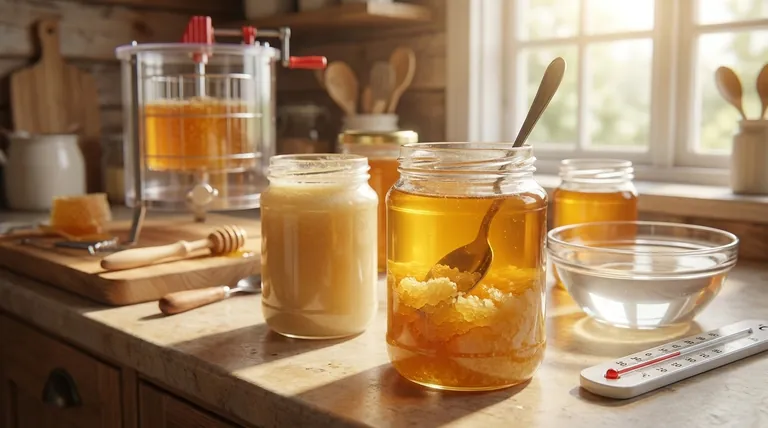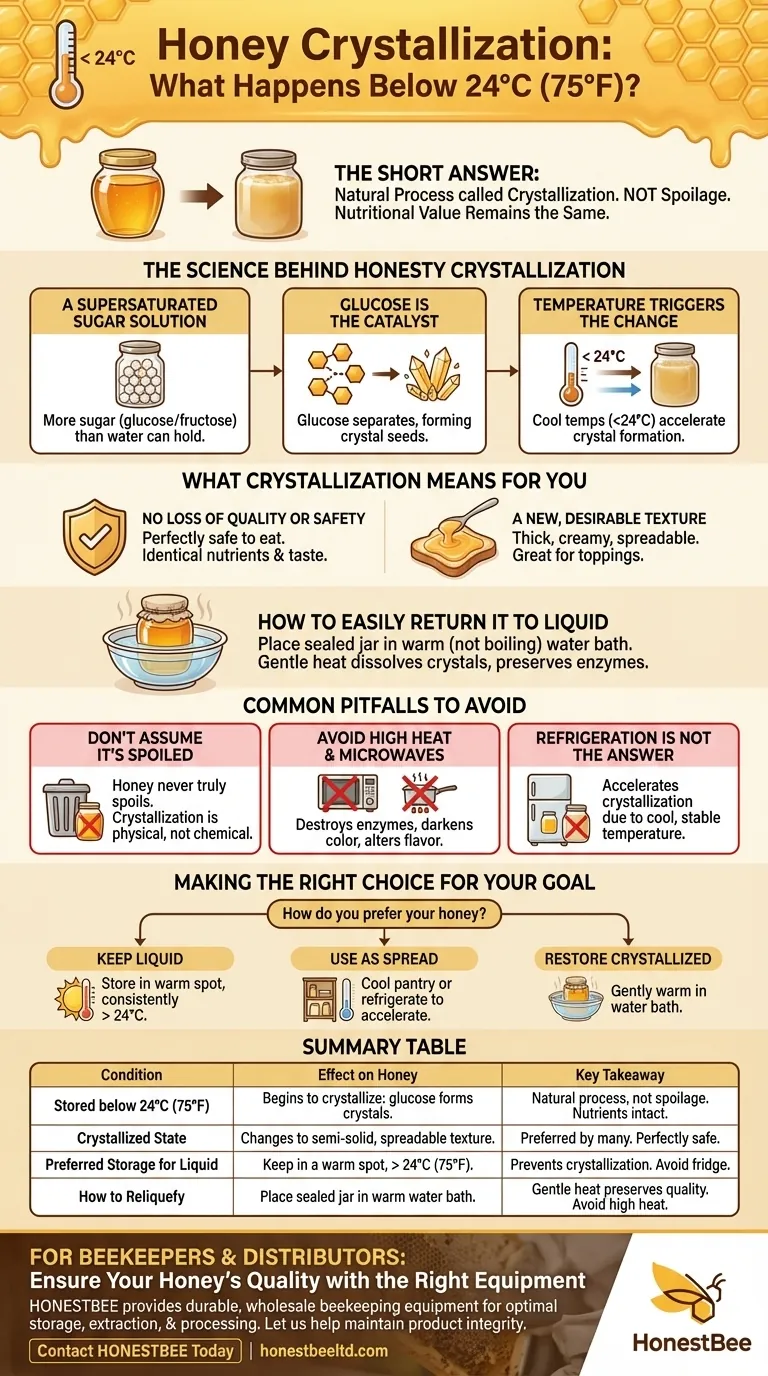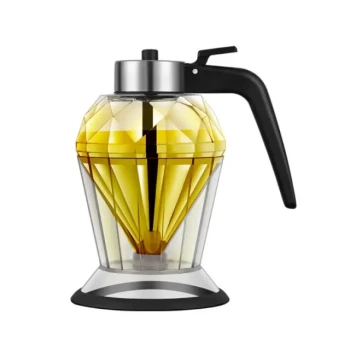The short answer is simple: When honey is kept at temperatures below 24°C (75°F), it begins a natural process called crystallization. This is not a sign of spoilage; in fact, the nutritional value of the honey remains exactly the same whether it is liquid or crystallized.
Crystallization is a natural transformation of honey from a liquid to a semi-solid state. It is an indicator of high-quality, raw honey and represents a change in texture, not a loss in quality or nutritional value.

The Science Behind Honey Crystallization
Understanding why honey crystallizes begins with understanding its composition. This process is entirely natural and predictable.
A Supersaturated Sugar Solution
Honey is fundamentally a supersaturated solution. This means it contains far more sugar (primarily glucose and fructose) than can be naturally dissolved in its small amount of water. This imbalance makes the solution unstable by nature.
Glucose Is the Catalyst
The primary driver of crystallization is glucose. Over time, and especially at cooler temperatures, the glucose begins to separate from the water content, forming tiny crystals that act as seeds for more to form.
Temperature Triggers the Change
Temperatures below 24°C (75°F) create the ideal conditions for this process to accelerate. The cool environment encourages the glucose molecules to precipitate out of the solution, causing the entire jar to solidify.
What Crystallization Means for You
While a jar of solid honey might seem concerning, it's actually a positive sign and is easily managed.
No Loss of Quality or Safety
Crystallized honey is perfectly safe to eat. It has not gone bad or spoiled. Its taste and nutritional properties are identical to its liquid form.
A New, Desirable Texture
Many people prefer the texture of crystallized honey. It is thick, creamy, and spreadable, making it an excellent topping for toast, scones, or oatmeal without the dripping of liquid honey.
How to Easily Return It to Liquid
If you prefer liquid honey, the fix is simple. Place your sealed jar in a bowl of warm (not boiling) water and let it sit. The gentle heat will dissolve the glucose crystals, returning the honey to its smooth, liquid state without damaging its delicate enzymes.
Common Pitfalls to Avoid
Misunderstanding crystallization can lead to mistakes that either don't work or actively harm the quality of your honey.
Don't Assume It's Spoiled
The most common error is throwing away perfectly good honey. Because of its low water content and high acidity, honey is one of the few foods that never truly spoils. Crystallization is a physical change, not a chemical one.
Avoid High Heat and Microwaves
Never use a microwave or boiling water to reliquefy honey. Excessive heat can destroy its beneficial enzymes and antioxidants, darken its color, and alter its delicate flavor profile. Gentle, gradual warming is always the best method.
Refrigeration Is Not the Answer
While we refrigerate most foods to preserve them, putting honey in the refrigerator will actually accelerate crystallization. The cool, stable temperature of a fridge is the perfect environment for crystals to form rapidly. The best storage spot is a pantry at a stable room temperature.
Making the Right Choice for Your Goal
How you store and handle your honey depends entirely on how you prefer to use it.
- If your primary focus is keeping it liquid: Store your honey in a warm spot in your kitchen, ensuring the temperature consistently stays above 24°C (75°F).
- If your primary focus is using it as a spread: Allow your honey to crystallize naturally by keeping it in a cooler pantry, or even accelerate the process by storing it in the refrigerator.
- If your primary focus is restoring crystallized honey: Gently place the jar in a warm water bath until the crystals dissolve, stirring occasionally.
Ultimately, understanding this natural process empowers you to enjoy high-quality honey in whichever form you prefer.
Summary Table:
| Condition | Effect on Honey | Key Takeaway |
|---|---|---|
| Stored below 24°C (75°F) | Begins to crystallize; glucose forms crystals. | Natural process, not spoilage. Nutritional value remains intact. |
| Crystallized State | Changes from liquid to a semi-solid, spreadable texture. | Preferred by many for its creamy consistency. Perfectly safe to eat. |
| Preferred Storage for Liquid Honey | Keep in a warm spot, consistently above 24°C (75°F). | Prevents crystallization. Avoid refrigeration, which accelerates the process. |
| How to Reliquefy | Place sealed jar in a bowl of warm (not boiling) water. | Gentle heat preserves enzymes and flavor. Avoid microwaves or boiling water. |
For Beekeepers & Distributors: Ensure Your Honey's Quality with the Right Equipment
Understanding honey's natural behavior is key to managing its quality from hive to shelf. Whether your commercial apiary or distribution business needs equipment for optimal honey storage, extraction, or processing, HONESTBEE has the wholesale supplies to support your operation.
We provide durable, high-quality beekeeping equipment designed for the demands of commercial-scale beekeeping. Let us help you maintain the integrity of your product.
Contact HONESTBEE today to discuss your wholesale supply needs and keep your honey business thriving.
Visual Guide

Related Products
- HONESTBEE 3-Frame Manual Acrylic Honey Extractor
- HONESTBEE 72 Frame Industrial Electric Honey Extractor for Beekeeping
- Professional Cone-Shaped Honey Filter with Reinforced Steel Ring
- 24 Frame Honey Extractor Commercial Radial Honey Frame Extraction Machine
- electric honey extractor honey centrifuge 3 frame honey extractor stainless steel honey frame extractor
People Also Ask
- What is a fun and easy alternative to using a honey extractor for harvesting honey? Try the Crush and Strain Method
- What size honey extractor do I need? Match Frame Capacity to Your Hives for Maximum Efficiency
- How to extract honey by hand? A Guide to Crush & Strain vs. Manual Extractors
- What equipment is used for honey harvest? Essential Tools for Every Beekeeper
- Which type of honey extractor is generally more durable? Focus on Material & Build Quality for Longevity



















